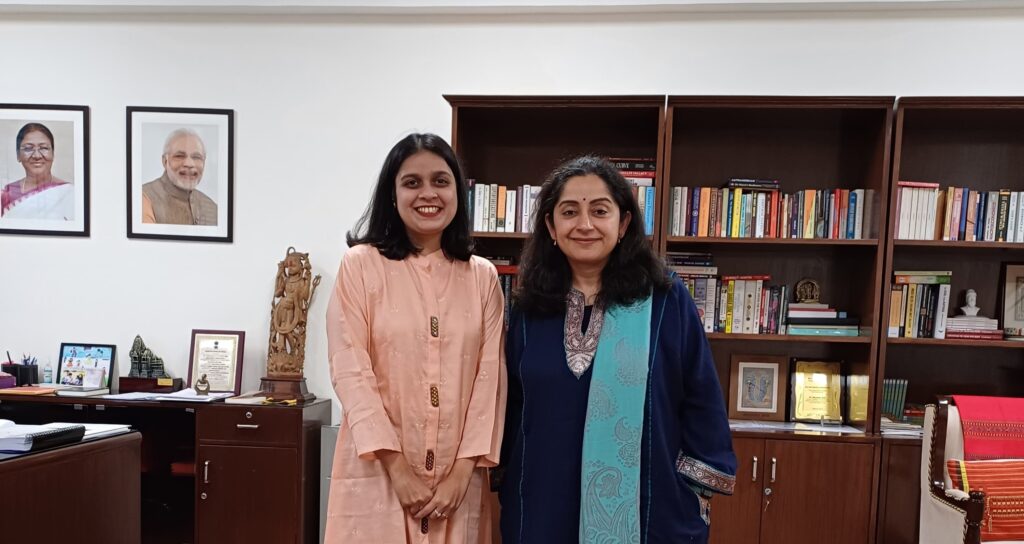
Women in Policymaking with Dr. Shamika Ravi: Understanding the Indian Economy & Way Forward
- As the Member of the Prime Minister’s Economic Advisory Council, how do you envision the path of achieving Vikasit Bharat by 2047? Which factors you think will contribute it to the most?
Viksit Bharat is not a destination rather a continuous process for our national progress and development. India shall keep on upgrading itself with global and domestic socio-economic, technological changes and our contribution shall be in terms of adapting to the relevant changes or bringing about the changes within our country and society. We are the most populous country in the world and our demographic dividend is our major asset. The active labour force, their productivity, the startup ecosystem and the facilitating public infrastructure are the driving forces for Vikasit Bharat. So essentially, people and technology are the biggest contributors.

So essentially, people and technology are the biggest contributors to become
Vikasit Bharat by 2047!
- As an economist, which sectors or areas wherein India has made a lot of progress and areas or sectors where India requires improvement?
India is a major and complex economy, whose growth is not merely dependent on a few sectors unlike say Bangladesh or Vietnam. So while IT exports are a well-known story, few realise the massive gains Indian economy has made in agriculture, pharmaceuticals, infrastructure, financial sector, real estate sectors etc. Our growing economy has been majorly fuelled by government capital expenditure in core connectivity sectors like roads, ports, telecommunications, payments, banking etc. which have been ably complemented by private sector growth. Unlike other Asian economies which have undergone export-led growth, our domestic markets are a major contributor to our growth. Similarly, major investments are needed to enhance human capital productivity in the country. These include investments in education, skills, healthcare and financial literacy at individual levels. India has reoriented it’s economy towards the manufacturing sector after losing almost a decade to the belief that “India has missed the manufacturing bus”. India’s new industrial policy including PLIs is in response to new global realities where major economies are realigning their supply chains away from China.
A sector where we have to catch up is urbanisation and urban planning. India’s real economy is moving very fast and the urbanisation process is significantly ahead of our administration and governance capacity. While policymakers believe in the Gandhian philosophy that India lives in its villages, in reality, India is mostly urban – nearly 65%! Administration, financing and governance of cities are very distinct from villages. We have to play catchup urgently.

Leveraging domestic market, expanding manufacturing sector & developing cities are areas on which India need to focus on.
- What kind of a role data plays in an economic policymaking?
Extremely important! Without quality data, here I am referring to quality data and not just large amounts of data, how can one analyse a country’s current (& future) situation objectively and make appropriate policy recommendations? We have to monitor different parameters, whether we are improving or not improving or whether there are unintended consequences. Therefore, it is of utmost importance to collect and analyse real-time data for the economy, at the national and local levels.
To understand the economy, what could be better than data?
To be specific, having huge data does not replace the need to have quality data. We are now even utilizing data generated through satellite images by ISRO etc. This is allowing us to understand where are we now, and where we need to reach for inclusive economic growth.

Data is the fuel to drive growth and development.
- We have been hearing buzz around the word ‘Policy Reforms’, can you elaborate what does it mean and why so much of importance should be given to it?
Policy is basically government’s action or inaction to solve a socio-economic issue. These are prepared for certain specific time and context. As our economy and society evolve, the issues and concerns that we have to focus on change. The context in which the policy is formulated also changes over time. Many problems are resolved through the markets and within communities among people themselves. But there are certain market failures where the need for government intervention becomes necessary. Some example are healthcare, primary education, pollution problems, defence, basic research and innovation, certain kinds of infrastructure etc.
Over time, the nature of the problem also changes hence policies need to be refined and reformed. If we continue with older policies then it will not yield the expected outcomes. The government has to follow some core principles of economics while utilizing resources optimally since there are multiple uses for this scare resource. And to do this, the changes or reforms in existing policies are necessary.

Changing society, people, environment, & issues
in different directions than
earlier calls for
Policy Reforms!!
- To identify such policy areas what kind of an analysis should be conducted?
Identification of core areas of policy focus is as much scientific enquiry as political pragmatism.
One can start by asking rudimentary questions such as how large is the problem? What is the prevalence? Then one goes on to do more nuanced analysis involving likely solutions and their cost effectiveness etc.
Data is extremely critical for such analyses. It will answer many of the questions you can think of. Start with basic trend analysis and then go to the level of sophisticated econometric analysis. Be mindful of the data that you are using. Many a time the data is not quantitative but rather a categorical or qualitative data, in such cases, the analysis also has to be in line with or appropriate to the data.

Asking relevant questions forms the appropriate base for any analysis.
- Would you like to throw some light on importance of public dissemination of information with respect to analysis, government policies and schemes?
Public dissemination of research and information is also an important public good. Government policies and schemes are formulated for the public hence people have all the right to know about them. It is the responsibility of government, public institutions and also academia to properly analyse, and simplify the main findings for easy communication.
Along with them, civil society organizations can help in distributing the information to the grassroots level so that the government schemes reach all intended beneficiaries.

Dissemination of information is the prerequisite for awareness generation among citizens.
- What would be your word of advice for budding analysts?
My suggestion would be to get first-class training in methodology. After that don’t keep waiting for someone to come and define research agendas for you. It is a large country with a dynamic economy – you have much to contribute even with seemingly simple analysis.
Also, put in the marginal effort to publish your work so that more people can read and benefit from it.
Also, my one suggestion to youngsters, whether analysts or otherwise, is to be careful with your expenses. Plan your expenses and investments carefully. With the easy availability of credit through personal loans, debt among the youth population is increasing. In the short run, this does not seem like a serious issue but will become one over time.
Knowledge-sharing platform is aimed at providing analytical insights into Economy, Public Policy and Foreign Policy.



Great conversation.. Informative 🙂